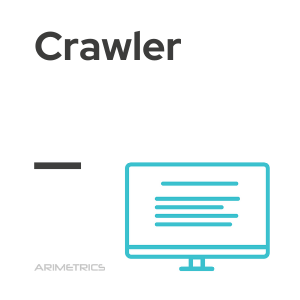
Meaning:
A crawler or web crawler, also known as a spider, is a bot that helps in indexing the web. They browse one page at a time through a website until all pages have been indexed. Web crawlers or crawlers help in collecting information about a website and the links related to them and also help validate HTML code and hyperlinks.
How crawlers work
Web crawlers collect information such as the URL of the web page, the information of the meta tags, the content of the web page, the links on the web page and the main destinations of those links, the title of the web page and any other relevant information. They keep track of URLs that have already been downloaded to prevent the same page from being downloaded again.
A combination of policies such as re-visit, selection policy, parallelization policy and courtesy policy determines the behavior of the web browser. There are many challenges for web crawlers, due to the continuous evolution of the network, the advantages and disadvantages of content selection, social obligations and facing competition.
Crawlers and search engines
Web crawlers are the key components of the web search engines and systems you see on web pages. They help in the indexing of web entries and allow users to submit queries in the index and also provide the pages that respond to queries. Another use of web crawlers is to archive websites, which involves large sets of web pages to be collected and archived periodically. Web crawlers are also used in data mining, where pages are analyzed for their different properties such as statistics, and are also used for data analysis.
Using Crawlers
Crawlers are mostly used to collect data from other websites with which to create a much larger database than you could otherwise. To extract the data, the different search engines are used that analyze the sites and give them a position in the SERPs, among other things.
These crawlers analyze ecommerce prices, external links, internal links, addresses, emails… Of all the pages you find and then organize that information.
Types of Crawlers
RBSE (Eichmann, 1994) this crawler was the first to be published and is based on two programs fundamentally, the first, spider, maintains the relational database and the second program, mite, downloads the web pages.
World Wide Web Worm (McBryan, 1994) this crawler collects the data and builds an index of titles and urls of the pages.
Google Crawl (Brin and Page, 1998) this crawler based on C++ and Python, travels the Internet extracting the information from the domains and analyzing if that data is new or was already there when it happened previously. If it is not, add the document to the database.
There are many more crawlers, used for many things, some of them unethical and legal, I invite you to look for more information about the operation of these content indexers.
How to block Crawlers
If you do not want any of the existing crawlers to enter your website and take information, you can block them through the robots file.txt. To do this you have to use the User-agent: directive and the name of the bot you do not want to access and Disallow: /. In the case of Google, the user agent would be Googlebot and in the case of the Semrush tool, User-agent: SemrushBot Disallow: /
User-agent: SemrushBot-SA Disallow: /
